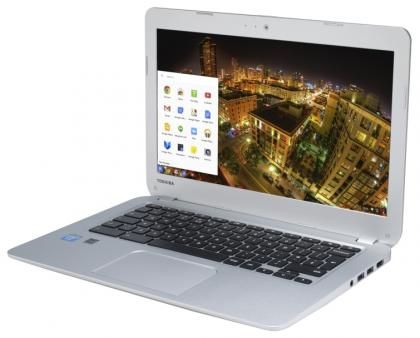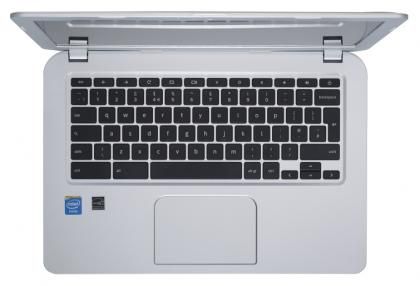The CB30-102 Chromebook is Toshiba’s first laptop designed to run Google’s web-centred Chrome operating system. The Toshiba Chromebook CB30-102 isn’t particularly exciting to behold, but it has a specification that matches rival Chromebooks from Acer and HP.
The CB30-102’s 13.3in screen makes it larger than many other Chromebooks. Even so, the CB30-102 weighs only 1.5kg and is 20mm thick. You’ll certainly have no trouble carrying it around.

BUILD It’s a shame that the CB30-102 is made of a silver plastic that feels very cheap; its lid has a light, dotted texture that does little to spice up the design. HP’s Chromebook 11 and Acer’s C720 are proof that design flair on a budget is possible, but at least the Toshiba CB30-102 feels reasonably sturdy.
The keyboard’s keys are nicely spaced, and typing on the CB30-102’s keyboard is a fairly comfortable experience. The keys don’t have much travel but we soon got used to the feel of the keyboard. The trackpad on the CB30-102 is a solid performer, although it has a little bit of give to it when tapped, which makes it feel cheap.

The CB30-102’s speakers are found underneath the front of the device and are impressively loud and the sound quality is surprisingly good. There wasn’t enough bass and the high-end sounded a bit tinny, but the CB30-102’s speakers are still better than those of many other laptops.
There are few connection ports in comparison to full-size Windows laptops, but the CB30-102 gives you the essentials you need. There’s a combined microphone and headphone jack, an SD card reader, a full-size HDMI output and a pair of USB3 ports. The USB3 ports are particularly useful for people working with large files who don’t want to fill up the CB30-102’s tiny 16GB SSD.


WiFi and Bluetooth are also present, but the device lacks an Ethernet port, unlike HP’s 14in Pavilion Chromebook. There’s no SIM-card slot either, so you you’ll have to tether the CB30-102 to your smartphone or connect to a portable router to access 3G or 4G networks.
DISPLAY The laptop’s plastic shell houses a 13.3in backlit LCD display which benefits from Toshiba’s TruBrite technology. The screen’s resolution is 1,366 x 768 pixels, which provides enough resolution to watch 720p video.
The screen looks good at maximum brightness, but we’ve seen laptops with better viewing angles. Image quality was by no means poor, but contrast was badly affected by screen angle. The CB30-102’s screen is glossy and does little to deflect sunlight. Happily, it does have a wide angle of adjustment, so finding a comfortable viewing position is easy.
The Toshiba CB30-102 Chromebook is powered by a dual-core Intel Celeron 2955U processor running on Intel’s Haswell architecture. The Celeron 2955U is ideal for the Chromebook line, and provides enough power for fairly intensive web browsing, 720p video playback and document editing. This power, combined with the Celeron’s integrated graphics processor and 2GB of memory meant we could enjoy games such as Bastion and Cut the Rope. It’s worth noting that large images were slow to load.
The Celeron 2955U also powers the Acer C720 Chromebook, and we’d expect the two devices to perform similarly when benchmarked. However, the Toshiba CB30-102 completed the SunSpider JavaScript benchmark in 451.4ms, which is much slower than the Acer C720’s score of 355.6ms. To be honest, you probably won’t notice the difference in normal use, but you might notice a difference between the C720 and CB30-102 when running processor intensive tasks.
The CB30-102 boots quickly, loading Chrome OS in under eight seconds and becoming ready for use with 15 seconds.






Leave a Reply